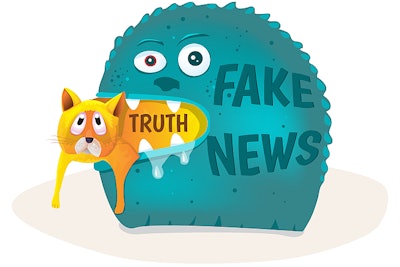
Misinformation, fake news, false beliefs and rumors have persistently caused problems for the pet food industry. From dilated cardiomyopathy to by-products to pentobarbital, diverse topics have spawned their own sets of rumors and false beliefs about dog, cat and other pet foods. Along with these specific myths, pet owners often harbor wider misunderstandings about pet food formulation, processing and regulation. What’s more, the popular news media makes erroneous reports, such as claiming that corpse chemicals are used as palatants. To form a bulwark against this bologna, pet food companies may need to engage with customers beyond the traditional model of consumer education. Games may help inoculate both pet owners and those in the industry against these inaccuracies and prepare players to debunk fake pet food news on their own.
A set of video games developed at the University of Cambridge were originally intended to counteract the flood of falsehoods that overwhelm online platforms. Their goal was mostly to protect people against deceptions in that murky realm where science and politics muddle, such as climate change and the pandemic. Yet, people use the same techniques to deny fossil fuels’ connection to global warming that other folks use to claim dog food is mostly filler. Both may rely on supposed evidence presented by assumed authorities with something to gain by deception. Similar methods exploit cognitive biases to propagate unfounded claims about microchips in vaccines or euthanized dogs rendered into meat slurry. Fear motivates people to believe things that don’t stand to reason, despite a lack of evidence. People fear horrific conspiracies but overlook mundane deceptions.
The game Bad News teaches players how to carry out those mundane deceits, using polarization, conspiracy theories, discrediting, trolling or invoking emotion. Players advance as they rile up followers, build their own brand, attack opponents and develop perceived credibility. While designed around political and social topics, the tenets of the game could apply to rumor-mongering about purportedly dangerous pet foods. In another game, GO VIRAL!, players learn how certain social media posts spread more than others. The game uses the false claim that Big Pharma’s toilet paper hoarding fuels Amazonian deforestation. The filter bubble created in the game then ensures a player gets reaffirming support for their belief in the #ToiletPaperVsNature scandal. Meanwhile, the player uses emotional language and relies on fake experts to push their anti-TP agenda. Fake experts also appear in a third game, Cranky Uncle. Players assume the identity of a climate change denier, who also uses logical fallacies and cherry-picking to reject the physical realities of global warming. The Cranky Uncle sets impossible expectations for empiricists while granting credence to conspiracies and quacks. The concepts behind these three games could be adapted to reject pet food fallacies.
History of fake news in journalism
Mass deception has never been easier in human history. The empirical methods of journalism and science stand as bulwarks against deceit, but the pet food industry may benefit from encouraging pet owners to use dispassionate observation. Games could be an innovative way to reach pet owners without lecturing. Traditional media streams have lost audience attention to the point where conventional advertisements may draw less attention than interactive, multimedia campaigns. Especially among younger pet owners, television and newspapers may no longer be effective means to get messages to pet owners. By initially considering online media streams to be an adjunct to print, many news industry organizations set themselves up for failure. People became accustomed to getting their news online for free and no longer subscribed to newspapers or other forms of paid journalism. No one buys a cow when the milk is free. This made news media businesses more dependent on advertisers since now their revenues were dependent upon making money from banners and clicks on websites.
The rise of do-it-yourself online news outlets and social media meant the decline of fact-checking and verification. Just as online sales of pet food decreased the influence of shelf location, so too the online environment removes many visual cues people used when buying their news. In 1980, the differences were clear between a national newspaper and a mimeographed sheet from some guy's basement. Not only did they look dramatically different, but they were also distributed differently. Now, comparisons between one webpage and another are not always so stark. While this makes it hard enough for adults to determine what is verified news and what is vilifying opinion, young people are growing up in this environment with limited guidance. Traditional educational systems haven’t adapted to the modern media environment. Children need to learn how to determine credibility from an early age, so they won’t fall victim to others’ self-serving deceptions. Not that that is anything new, since fake news is nothing new. Before it went by that name, there was yellow journalism. In the late 19th and early 20th centuries, newspapers were highly profitable and competitive. That mixture fueled inflammatory, provocative, inaccurate reporting designed to sell papers, not inform the public. That yellow journalism reached its crescendo with the Spanish-American War, a conflict that might not have occurred, but for sensationalist reporting.
William Randolph Hearst, the publisher of The New York Journal, dispatched Frederic Remington to Cuba to cover the guerilla uprising against Spanish imperial dominion.
"There will be no war," Remington wired Hearst.
Hearst replied, "You furnish the pictures, and I will furnish the war."
Hearst was locked in a battle for newsstand sales with Joseph Pulitzer's New York World. Wars sell papers. If it bleeds, it leads, is an old adage in the newspaper trade. Hearst got the perfect war-making pictures after the sinking of the American battleship Maine in Havana harbor on Feb. 15, 1898, which likely occurred after a coal bunker fire exploded. However, newspapers fueled conspiracies that Spanish agents had attacked the U.S. The United States declared war on Spain on April 21. After the war ended in August, the U.S. controlled Cuba, Puerto Rico, Guam, and the Philippine islands. The Spanish Empire was dead and the U.S. continued its rise towards global influence. Fake news helped it happen.
However, deceiving others about the magnitude of a threat likely predates humanity.
“Mike’s rise to the number one or top-ranking position in the chimpanzee community was both interesting and spectacular. In 1963 Mike had ranked almost bottom in the adult male dominance hierarchy… One day at camp, all at once Mike calmly walked over to our tent and took hold of an empty kerosene can by the handle…Armed with his two cans Mike stared toward the other males… As he called, Mike got to his feet and suddenly he was off, charging toward the group of males, hitting the two cans ahead of him. The cans, together with Mike's crescendo of hooting, made the most appalling racket,” Jane Goodall - "In the Shadow of Man"
Soon, Mike had even unseated Goliath, the huge dominant male. Mike’s cans were fake news. There was no great threat to the other male chimps, but Mike made the other apes think there was. Homo sapiens didn’t diverge far from Pan troglodytes in this. Unfamiliar, startling and loud noises help humans rise in social standing. That’s essentially what many conspiracy theories are, just scary false alarms. Harmless things can be made to seem terrifying, while at the same time the truly terrifying can be overlooked.
The chimps should have been worried that the presence of humans, and their cans, meant they may soon face habitat loss. Chimps lack the ability to see those larger scale threats. In the short term, making noise to rise in standing was the best use of these unfamiliar objects. Another primate species also developed a new tool capable of raising a ruckus. Those primates, the ones writing and reading this article, may find ways to use digital media as a more beneficial tool than a scary noisemaker, and we may instead inform ourselves how to best serve the animals we share our lives with.













